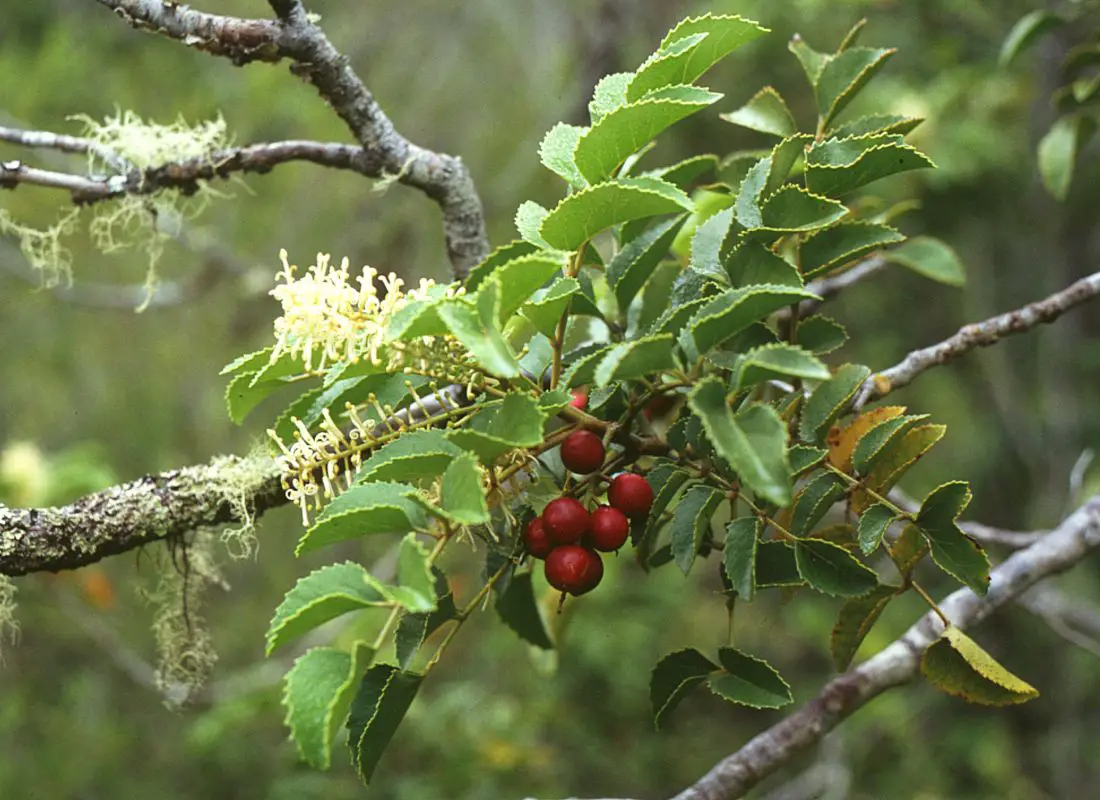

Image – Wikimedia Commons / Franz Xaver
The Chilean hazelnut It is a very interesting fruit tree to have in gardens and orchards that enjoy a temperate climate and even with cold winters; in fact, it can live and develop without having any kind of problem in areas where the temperature drops to -12ºC once established, which is very interesting, don’t you think?
If we talk about its maintenance, does not require complicated or continuous care as long as the conditions in which he lives are adequate.
Characteristics of the Chilean hazelnut


Our protagonist, whose scientific name is Hazelnut Gevuinais an evergreen fruit tree (that is, it remains green throughout the year), whose height can be between 3 and 20 meters. Its leaves are bright green, and its flowers are grouped in long, axillary, creamy-white clusters. The fruit, the hazelnut, is an edible black walnut.
Its cultivation and maintenance is simple, as I am going to tell you below. So much so that it is often planted in gardens in many parts of the world, such as those in Ireland or California.
Chilean hazelnut care


Image – Wikimedia Commons / Yeast
If you want to have a Chilean hazelnut, you must take into account the following:
Location
It is a tree that, due to the dimensions it reaches as an adult, and its needs, has to be placed outsideIn semi-shade, protected by trees or tall hedges, especially young, which is when it is most sensitive to cold, supporting only up to -4ºC. But, once it grows up, it can take quite a bit more.
Irrigation
Chilean hazel does not resist droughtBut he doesn’t like waterlogging too much either. It is a plant that requires regular watering throughout the year, being frequent during the summer and somewhat scarcer the rest of the seasons.
Water at sunset or first thing in the morning, so that on the one hand the tree can have more time to hydrate, and secondly so that you can save some water.
Use rainwater whenever you can, or without lime. In the event that you only have the tap and it is very hard, with a high concentration of lime, fill a container with it and let it rest overnight. The next day you can use the one in the upper half of said container, trying not to move the water too much.
Earth
- Garden: it must be fresh, rich in organic matter and with good drainage.
- Flower pot: It is not a plant that can be grown in a pot throughout its life, but it can be grown during its youth. In the event that you are going to have it in one, fill it with a mixture of mulch and 20% perlite or similar.
Transplant
Whether you want to transfer it to the ground or to a larger pot, you must do it in springwhen the risk of frost has passed. You will know that it is time to transplant it when you see the roots come out of the drainage holes of the pot, or when it has already occupied it all to the point that its growth seems to have stopped.
Do it carefully not to manipulate its roots too much, because if it suffers damage it will cost more to overcome it. For this reason, the ideal is to water it conscientiously the day before, so that the grains of earth that form the substrate are more ‘together’ of each other, thus achieving that once you want to remove the plant from the pot , the root ball or earth bread does not crumble.
Subscriber
In order for you to grow with health and strength, it is very interesting to pay it in spring and summer with Organic fertilizers such as worm castings or horse manure.
If it is in a pot, you can use liquid fertilizers such as guano following the instructions specified on the product packaging.
Pruning
It is not necessary to prune the Chilean hazelnutbut it is advisable to remove dry branches, weak ones and those that are broken at the end of winter with pruning tools disinfected with a disinfectant or similar product, such as pharmacy alcohol, or dishwasher.
Multiplication
Chilean hazel multiplies by seeds in springwhich can be sown in seedbeds with equal parts peat and perlite. Place the seedbed outside, in semi-shade, and keep the substrate moist (not waterlogged).
If all goes well, they will germinate throughout the season.
Rusticity
Resists frosts down to -12ºC once adult and established, and high temperatures of up to 40ºC.
What uses does it have?


Image – Flickr / Dick Culbert
It is a very beautiful plant, with multiple uses:
Ornamental
It can be kept as an isolated specimen, in alignments or in groups. It is a magnificent species, which provides good shade and also does not need much care.
Culinary
Its fruits are ediblebeing able to eat as dessert, or as a snack, either raw, cooked or boiled. They are a good source of vitamin E and beta-carotene, so your health will also benefit.
On the other hand, the honey produced with the nectar of its flowers has a pleasant flavor, consumed for example on toast.
Medicinal
the nuts help fight cholesteroland their oil is used to care for the skin for its antioxidant properties.
Wood
It is used in cabinetmaking, crafts and as an interior wall cladding.
Have you heard of the Chilean hazelnut?
